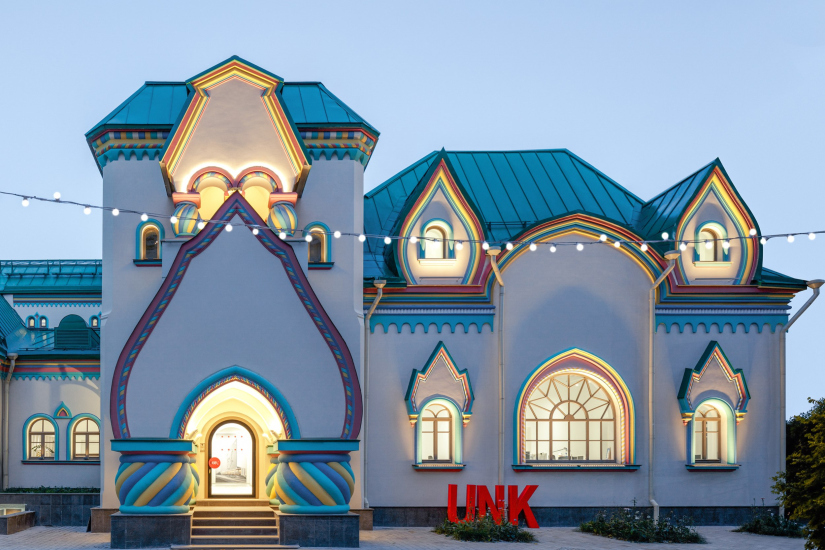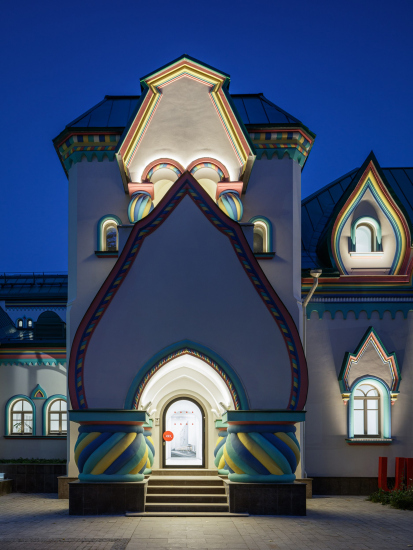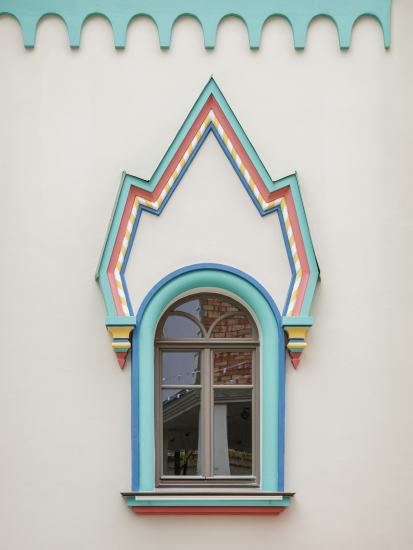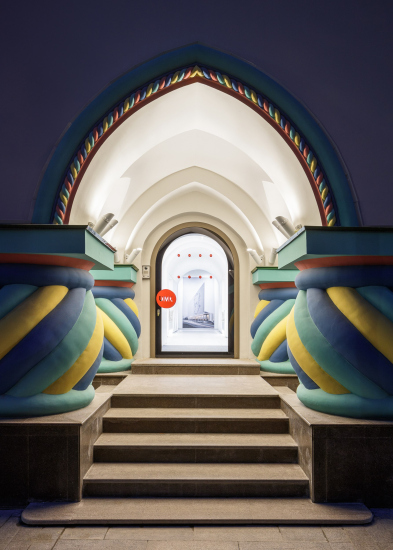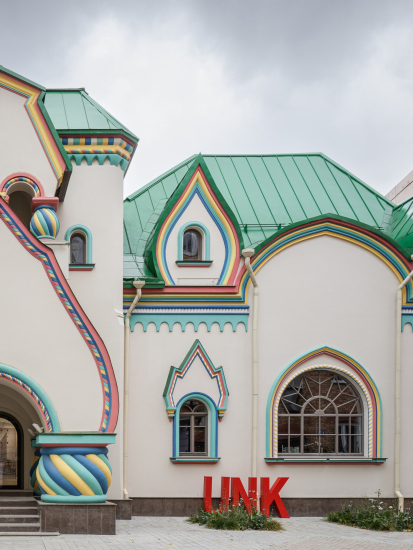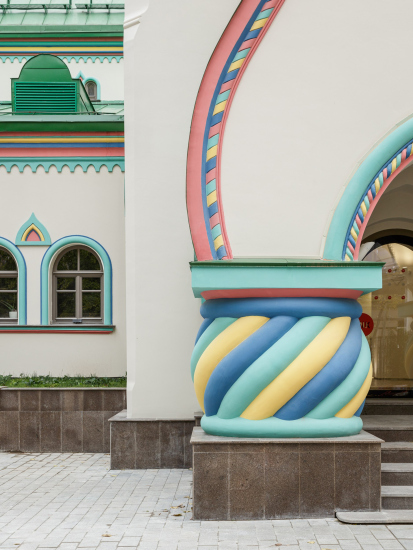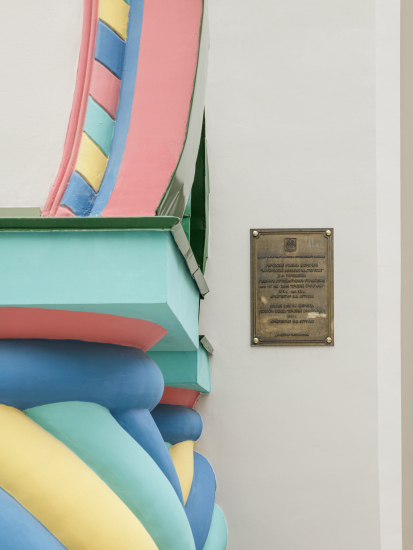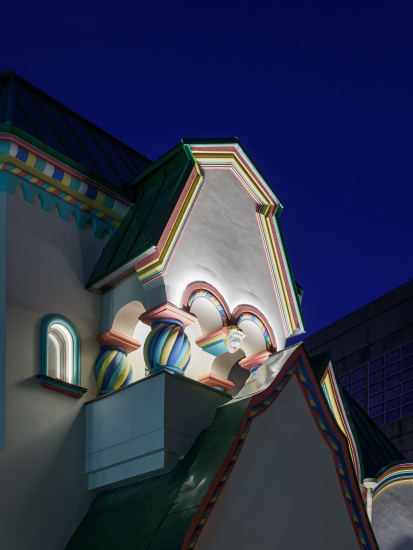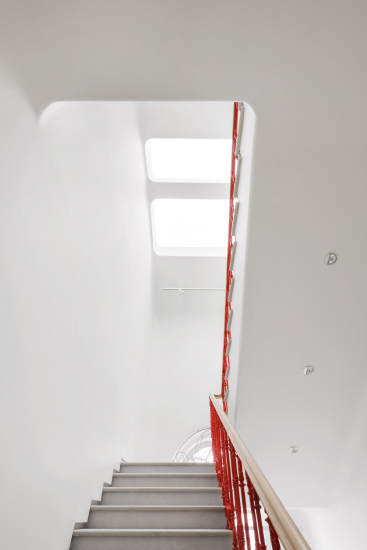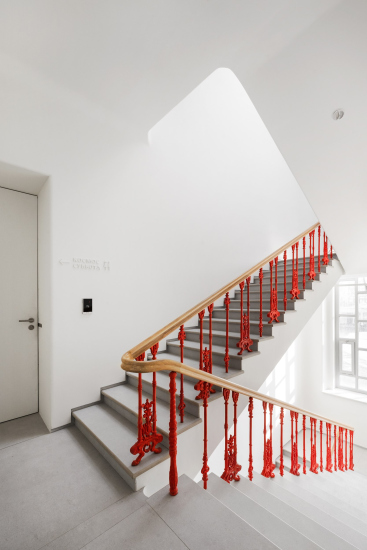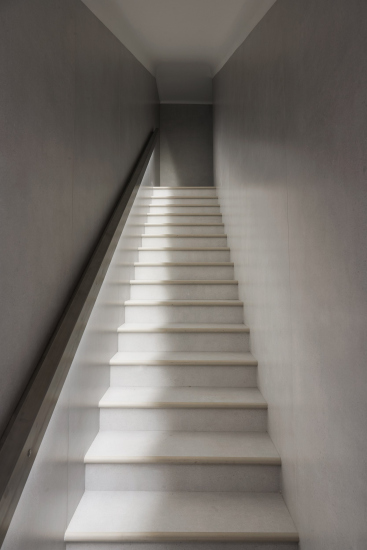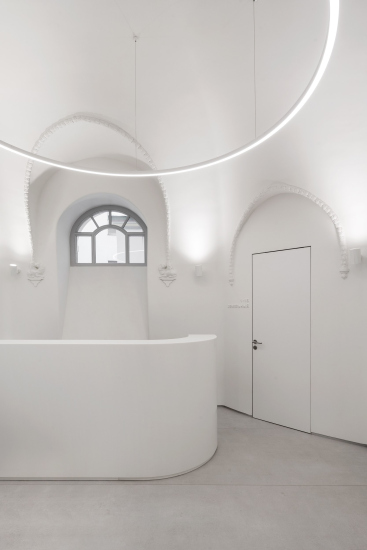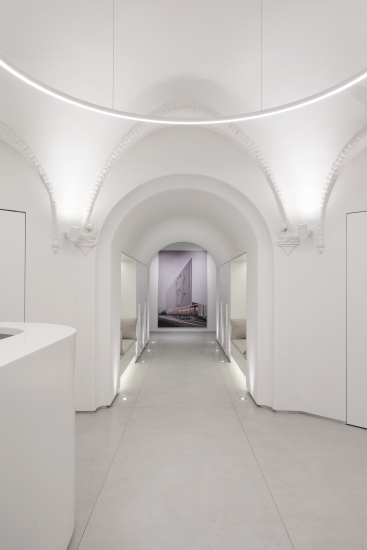For such an exotic Russian-style delicacy, there was – and still is – a fitting reason: UNK set up their office in a neo-Russian mansion from the early 20th century, built in 1911. Once, the head office of UNK was located on rented premises at the “Soyuz” factory, where the Luzhniki Collection residential complex is currently under construction. After that, the team was scattered all across Moscow, searching for “their home” and considering various options. While potential locations varied greatly, it is said that Julius Borisov insisted on a historical mansion. Indeed, modernists often enjoy working in historic buildings.
The mansion is the work of architect Sherwood. And here’s where the confusion begins – though it’s minor and easy to unravel. To their credit, UNK have created a detailed chronology of the mansion’s history – in the dining room, right on the wall, as is now trendy at exhibitions. They’ve also illustrated the mansion’s story with photographs, making the office feel like an exhibition in itself.
So, the confusion! It could arise, for instance, from the fact that the mansion is associated with architect Sherwood, but the project’s author was actually architect Nikolai Dmitrievich Butusov. At the time of the mansion’s completion, Butusov was 47 years old and Sherwood was 44. Both were young architects who had worked in eclecticism, neoclassicism, and modernism, and their biographies likely still await dedicated historians. Moving on: Vladimir Sherwood is not the one who designed the Historical Museum, but his son, Vladimir Vladimirovich, who, for example, created the neoclassical Titov revenue house on Old Square, located at the beginning of Ilinka Street. The Russian Sherwood architects were descendants of an English textile machine mechanic, William Sherwood, and the plot on Malaya Kaluzhskaya, now home to UNK, was the ancestral estate of his descendants. William received the plot after arriving in Moscow in 1809. In Russia, William became Vasily, and he had four sons and one daughter. One son, Ivan, who was born in England, is known for informing Alexander I about the Decembrist uprising, for which Nicholas I later added the title “Verny” (Faithful) to his surname. Another son, Joseph, was the father of Vladimir Sherwood and the grandfather of both sculptor Sergey Vladimirovich and architect Vladimir Vladimirovich. Once you start digging into architect dynasties, you can really get buried...
In 1812, William Sherwood’s house on Malaya Kaluzhskaya burned down during the Moscow fire and was later rebuilt. At some point – though probably not as early as 1813 – the Sherwood house became a wooden “Teremok” executed in a pseudo-Russian style.
The previous, wooden, Sherwoods′ Teremok in 1885; photo on display in the UNK office
Copyright: Photo © Sergey Volokitin / provided by UNK
In the mid-19th century, the house was surrounded by the Bromley factory. The factory was largely military, producing lathes for barrel turning and grenade casing, as well as ammunition. In Soviet times, it was known as “Krasny Proletariy” (Red Proletarian). Interestingly, Vladimir Sherwood Jr. was one of the architects of the Bromley factory. However, it was Nikolai Butusov who built the stone mansion. Why? We still don’t know.
Why am I telling you all this? Well, at the very least, to point out that UNK chose a location with significant, even familial, architectural history for their “nest”. It’s easy to notice that among the photos on the ground floor, the Sherwood family is placed alongside Julius Borisov’s family and colleagues – continuity is not only acknowledged but also emphasized.
Nevertheless, the architecture of “Teremok” itself is no less interesting. It appeared shortly before World War I and is an example of a fully developed “Neo-Russian” (or “Russian Revival”) style. There is almost nothing left of the pseudo-Russian style – except for the idea of giving this architectural monument a second life, revitalizing and reinterpreting it. This is not a colorful, fragmented, or even red-brick house with a “set-piece” design. It was influenced not only by the Diaghilev Seasons, Bilibin, and Vasnetsov; it represents a certain sum of reinterpreted ideas. Its forms are cohesive, large, and fluid; it’s a high-level example of modernism. You can see that the style here has reached a certain conclusion, standing at the threshold not only of historical upheavals but also of 20th-century art. This isn’t a fake imitation of 17th century chambers – this is a fairy-tale house, a theater house, or a stage set if you will.
Before the restoration, Teremok was, for some reason, painted yellow with green highlights; however, its original color scheme was white with colorful details, much like the nearby Church of St. Nicholas in Khamovniki. The architects at UNK told me that they initially planned to paint the facades entirely white. But during the façade restoration, they discovered the original color scheme and, after consultations with the Department of Cultural Heritage of Moscow, they decided to reproduce it true to the original. As a result, we now see the mansion’s facades as they were originally designed in 1911.
The facades are adorned with lively, colorful details. It must be said that this was a successful outcome: it highlights how positively contemporary this 1911 building is.
To some extent, Butusov’s Teremok even seems postmodern. Just look at the spiral, barrel-like columns on the porch – they look as if they were made from colorful 1980s chewing gum. Hundertwasser also comes to mind.
In short, Teremok stands as an example of modernism that had reached the “revolutionary” boundary and was ready to engage with contemporary art.
This is exactly what happens in the interior, where the architects were given free rein to fully explore the use of white.
“Our interior is like an egg” UNK architects say. And that’s quite accurate: you step inside, and it feels like entering a giant eggshell; images of spaceships (or even paradise?) from the movies come to mind. Everything is white, round, and glowing, and the edges and joints of the forms are often barely distinguishable. You really feel like a chick – it’s tempting to joke that we’ve entered the “egg of contemporary art”, or in this case, architecture. The egg is a metaphor with great potential; it’s enough to recall that in many myths, the world is born from an egg, making it an apt image for architectural creativity, which gives birth to both volume and space “out of nothing”, or at least out of some kind of passive matter.
These numerous “roundings” are part of Butusov’s original architecture but were also added in a few places: for instance, in the curved reception desk in the entrance hall, or in elements like plumbing fixtures, round tables, and circular and disc-shaped lamps. The designers amplified the potential of these curves, particularly with the help of disc lamps, bringing the abstraction of the circle to the forefront.
The whiteness is further emphasized by the lighting, including fixtures built into the floor or the handrail of the staircase leading down. The plasticity of the interior is quite unique: there are many curved surfaces, yet they don’t feel heavy, solid, or even corporeal. On the contrary, thanks to the whiteness and lighting, the structure feels ethereal, almost virtual, like something out of a film or video game, or as if it’s made from a sheet of white paper. In this way, another metaphor comes to mind, replacing the eggshell – the metaphor of a blank sheet, or perhaps a screen, an architectural “canvas” on which, or “within which”, ideas and forms are born.
Light, whiteness, and curving shapes are particularly noticeable on the staircase, where the architects introduced skylights, creating a “crescendo” in the development of the interior’s design.
It’s here, on the staircase, that we suddenly realize there is color in the interior. Color appears on a historical element – the cast-iron railings – and predictably, it’s bright red, UNK’s signature color. However, this red seems to lean towards a somewhat “Soviet” scarlet hue, likely due to the abundance of light streaming in from all sides.
Nevertheless, this accent is quite appropriate and even serves as the structural core of the building. Strictly speaking, a staircase is almost always the core of the building – functionally, symbolically, or both. Here, it seems all the elements come together, including the “shaft” of light: from the natural daylight streaming through the skylights to the delicate glow of the handrail’s lighting, leading down to the basement. As you descend, it might even seem like the light is spilling onto the steps from above, though that’s not the case. But the idea is carried through quite consistently.
I should note that while the façade’s “Russian Revival” style is very modern, flexible, and streamlined to a high degree of novelty, while the historical decor elements preserved inside are quite traditional and lean towards the 19th century. The cast-iron balusters of the stair railings are beautiful but relatively standard for their time; there’s no modernist fluidity in them, except perhaps a hint of Hoffmann’s “goat legs”. Maybe that’s why they were chosen as the color accent – because their form stands out from the flexible plasticity of the interior?
Another historical element, the relief nervures copied by Butusov from the Terem Palace and adorning the edges of the dome’s vaults in the entrance vestibule, were left white by the UNK architects. As a result, you don’t notice them when entering Teremok, but rather when leaving it.
When you enter, you first see two mirrors vis-a-vis, a familiar but always striking way to expand the space, and a photograph of the “Akademik” business center at the end of the corridor beneath the cylindrical vault.
This photograph is quite appropriate here. It not only directly shows that you’ve entered the architects’ office, but it also subtly introduces the incoming visitor to its conceptual structure. The office is built around UNK’s milestone projects – and Julius Borisov constantly emphasizes that his mission is to work with unique objects – thus, the navigation is organized on a “project-to-project” basis. Each meeting room has a name: “Saturday,” “Akademik”, “Atom”, “Orbital”. All of this is reflected on signs, which are everywhere, embossed and also white.
Color is present here not just as the scarlet accent of the railings. Since UNK has significant experience in designing office and public interiors, they followed modern trends in their own office as well: downstairs, in addition to a dining area, there is a public space with an amphitheater, and on all floors, starting from the entrance, there are cozy recesses for private conversations. Throughout, the pristine white is complemented by the natural greenery of plants from the “winter garden”, light wood accents, and fabric of similar hues on the sofas. The sofas don’t clash with the main theme; instead, they blend into the evenly glowing space and enhance it. In their curious “neutral” way, the sofas also enliven the inner space of the mansion.
Ultimately, the choice of the mansion turned out to be a good one.
And not only because the architects gained possession of a flashy-looking and interesting monument of Moscow architecture, which they restored, and which you feel more and more like visiting like an exciting guided tour of both history and modernity. And not even because they now also have a luxurious courtyard where the summer presentation of the new office took place, and inside there is not only a workspace but also a public area with an amphitheater and a large screen for lectures, a dining area with a kitchen, and many cozy “corners” for conversations, as is customary in modern office interiors. There is more to it than that!
In addition to all of the “common decencies” of the modern office that are perhaps worthy of mentioning, yet are hardly worthy of any excessive praise, the key aspect of this project is the intriguing dialogue between understanding architectural form as such and the search for modern identity. This building, back in its time, was at the forefront of novelty, designed in the spirit of Russian Revival, which was one of the trending styles back then. Needless to say, after coming full circle, the architectural agenda (or at least one of its agendas) has once again returned to questions of identity. Today, for those who dare to engage in such experiments, this search is even more relevant than it was a hundred years ago, but it takes place within a contemporary paradigm. In Julius Borisov’s projects, such experiments haven’t been noticed yet, but in their new office, UNK architects provide a more nuanced answer to the same question: by settling into a historic mansion in the “Neo-Russ” style, they conceptualized its interiors as ultra-modern, while still creating a clear stylistic connection between the building’s interiors and façades. Being here, you can feel that there are 112 years between them, yet they are like kindred spirits, continuing the same theme of flexible novelty, whiteness, and cohesive form. And that’s when it becomes clear how much our times have in common. It dawns on you that the theme that was set over a century ago continues to evolve even now.
In other words, you realize at this point that there is a certain mystery embedded in the very word combination “modern architecture”. It shouldn’t be taken too literally.




